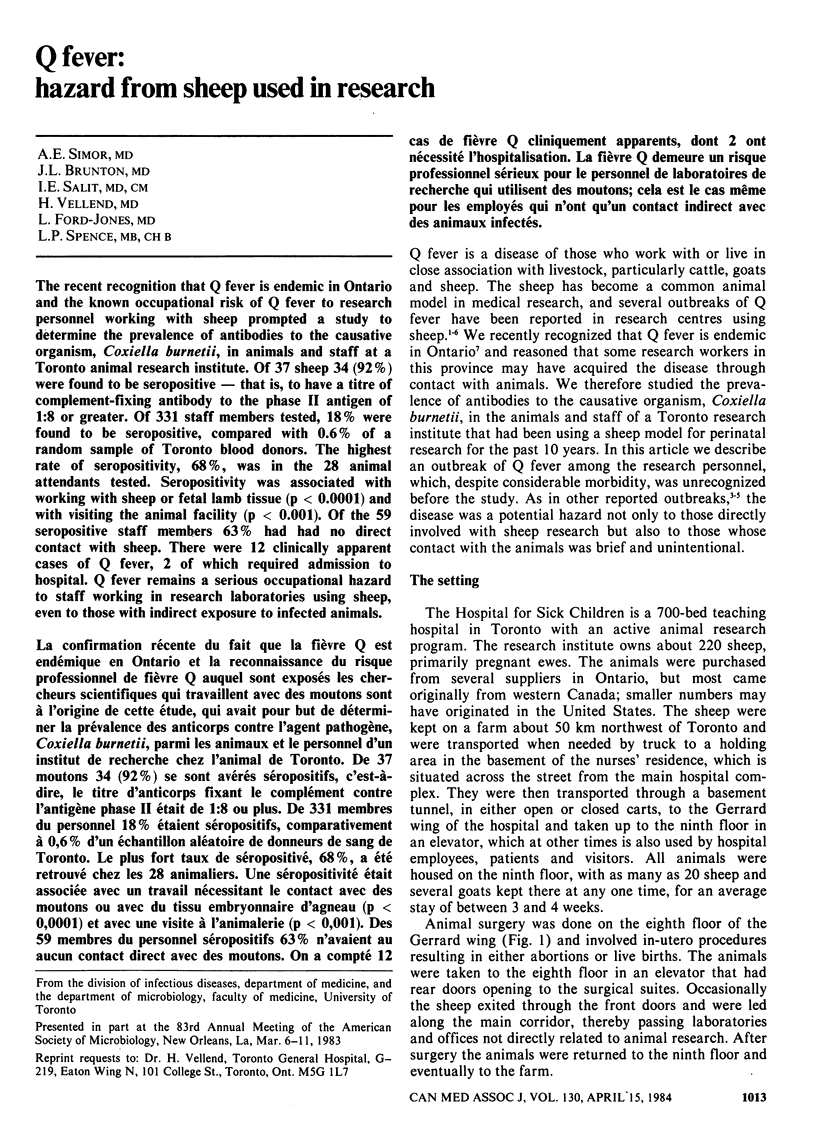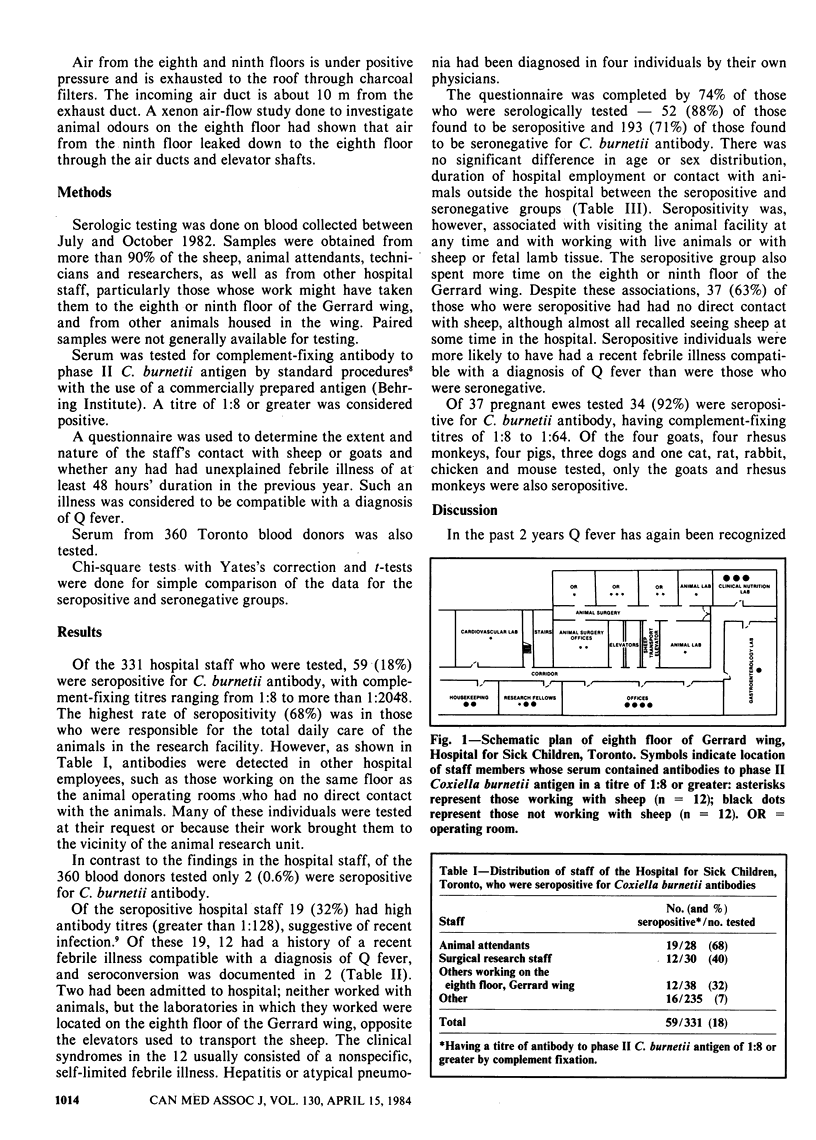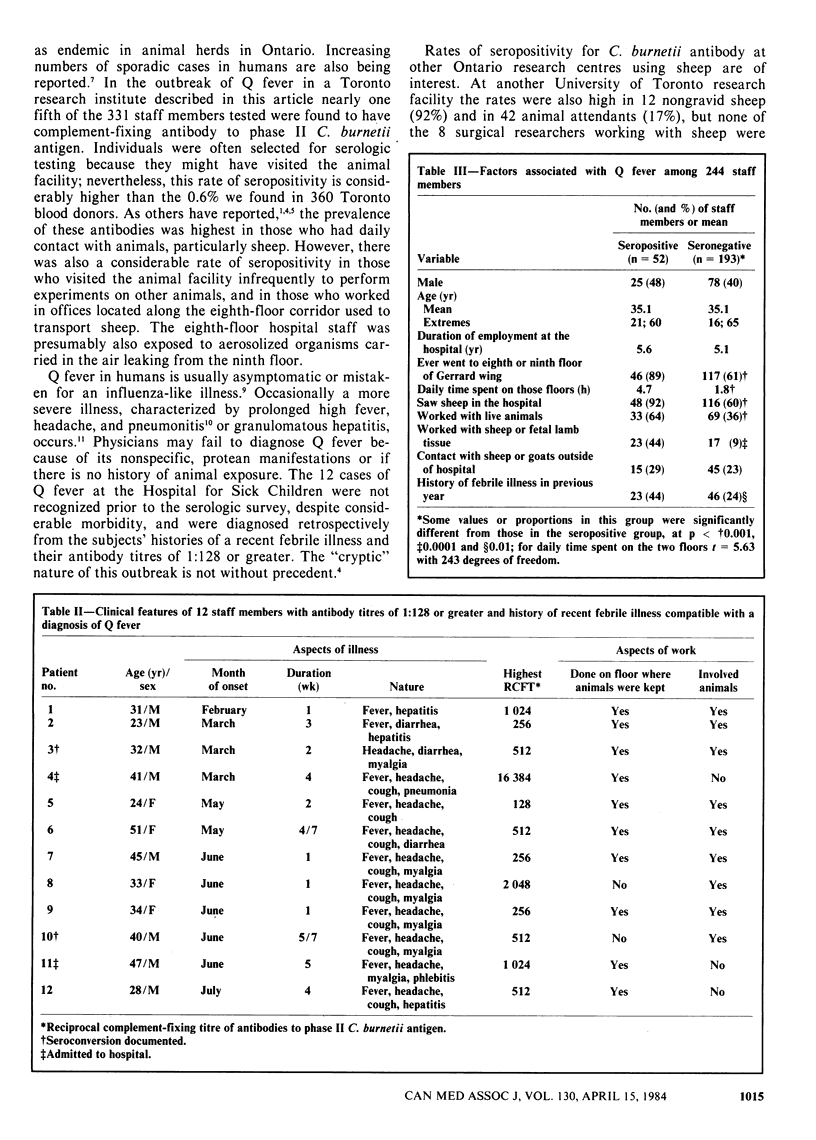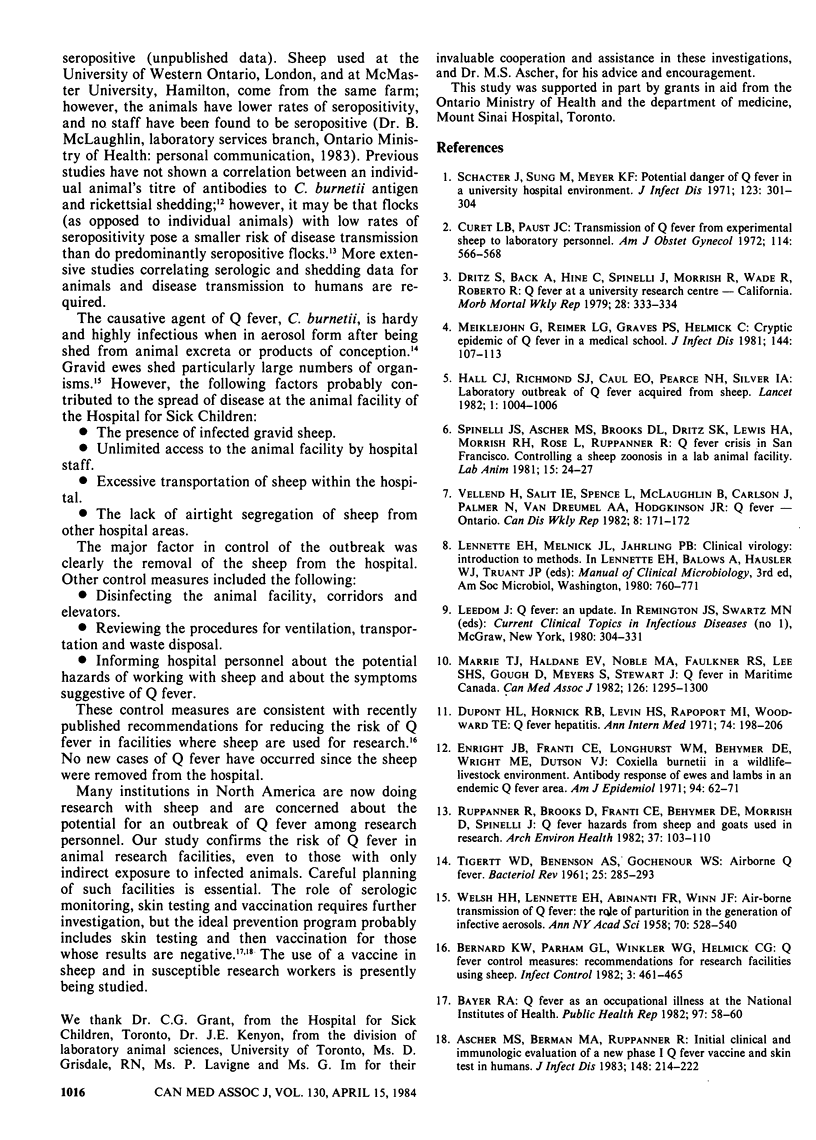Abstract
The recent recognition that Q fever is endemic in Ontario and the known occupational risk of Q fever to research personnel working with sheep prompted a study to determine the prevalence of antibodies to the causative organism, Coxiella burnetti, in animals and staff at a Toronto animal research institute. Of 37 sheep 34 (92%) were found to be seropositive--that is, to have a titre of complement-fixing antibody to the phase II antigen of 1:8 or greater. Of 331 staff members tested, 18% were found to be seropositive, compared with 0.6% of a random sample of Toronto blood donors. The highest rate of seropositivity, 68%, was in the 28 animal attendants tested. Seropositivity was associated with working with sheep or fetal lamb tissue (p less than 0.0001) and with visiting the animal facility (p less than 0.001). Of the 59 seropositive staff members 63% had had no direct contact with sheep. There were 12 clinically apparent cases of Q fever, 2 of which required admission to hospital. Q fever remains a serious occupational hazard to staff working in research laboratories using sheep, even to those with indirect exposure to infected animals.
Full text
PDF



Selected References
These references are in PubMed. This may not be the complete list of references from this article.
- Ascher M. S., Berman M. A., Ruppanner R. Initial clinical and immunologic evaluation of a new phase I Q fever vaccine and skin test in humans. J Infect Dis. 1983 Aug;148(2):214–222. doi: 10.1093/infdis/148.2.214. [DOI] [PubMed] [Google Scholar]
- Bayer R. A. Q fever as an occupational illness at the National Institutes of Health. Public Health Rep. 1982 Jan-Feb;97(1):58–60. [PMC free article] [PubMed] [Google Scholar]
- Bernard K. W., Parham G. L., Winkler W. G., Helmick C. G. Q fever control measures: recommendations for research facilities using sheep. Infect Control. 1982 Nov-Dec;3(6):461–465. doi: 10.1017/s0195941700056587. [DOI] [PubMed] [Google Scholar]
- Curet L. B., Paust J. C. Transmission of Q fever from experimental sheep to laboratory personnel. Am J Obstet Gynecol. 1972 Oct 15;114(4):566–568. doi: 10.1016/0002-9378(72)90222-0. [DOI] [PubMed] [Google Scholar]
- Dupont H. L., Hornick R. B., Levin H. S., Rapoport M. I., Woodward T. E. Q fever hepatitis. Ann Intern Med. 1971 Feb;74(2):198–206. doi: 10.7326/0003-4819-74-2-198. [DOI] [PubMed] [Google Scholar]
- Enright J. B., Franti C. E., Longhurst W. M., Behymer D. E., Wright M. E., Dutson V. J. Coxiella burneti in a wildlife-livestock environment. Antibody response of ewes and lambs in an endemic Q fever area. Am J Epidemiol. 1971 Jul;94(1):62–71. doi: 10.1093/oxfordjournals.aje.a121296. [DOI] [PubMed] [Google Scholar]
- Hall C. J., Richmond S. J., Caul E. O., Pearce N. H., Silver I. A. Laboratory outbreak of Q fever acquired from sheep. Lancet. 1982 May 1;1(8279):1004–1006. doi: 10.1016/s0140-6736(82)92001-3. [DOI] [PubMed] [Google Scholar]
- Marrie T. J., Haldane E. V., Noble M. A., Faulkner R. S., Lee S. H., Gough D., Meyers S., Stewart J. Q fever in maritime Canada. Can Med Assoc J. 1982 Jun 1;126(11):1295–1300. [PMC free article] [PubMed] [Google Scholar]
- Meiklejohn G., Reimer L. G., Graves P. S., Helmick C. Cryptic epidemic of Q fever in a medical school. J Infect Dis. 1981 Aug;144(2):107–113. doi: 10.1093/infdis/144.2.107. [DOI] [PubMed] [Google Scholar]
- Ruppanner R., Brooks D., Franti C. E., Behymer D. E., Morrish D., Spinelli J. Q fever hazards from sheep and goats used in research. Arch Environ Health. 1982 Mar-Apr;37(2):103–110. doi: 10.1080/00039896.1982.10667545. [DOI] [PubMed] [Google Scholar]
- Schachter J., Sung M., Meyer K. F. Potential danger of Q fever in a university hospital environment. J Infect Dis. 1971 Mar;123(3):301–304. doi: 10.1093/infdis/123.3.301. [DOI] [PubMed] [Google Scholar]
- TIGERTT W. D., BENENSON A. S., GOCHENOUR W. S. Airborne Q fever. Bacteriol Rev. 1961 Sep;25:285–293. doi: 10.1128/br.25.3.285-293.1961. [DOI] [PMC free article] [PubMed] [Google Scholar]
- WELSH H. H., LENNETTE E. H., ABINANTI F. R., WINN J. F. Air-borne transmission of Q fever: the role of parturition in the generation of infective aerosols. Ann N Y Acad Sci. 1958 Jun 3;70(3):528–540. doi: 10.1111/j.1749-6632.1958.tb35409.x. [DOI] [PubMed] [Google Scholar]


